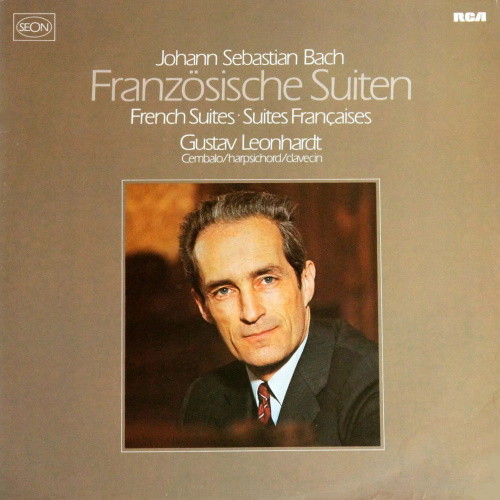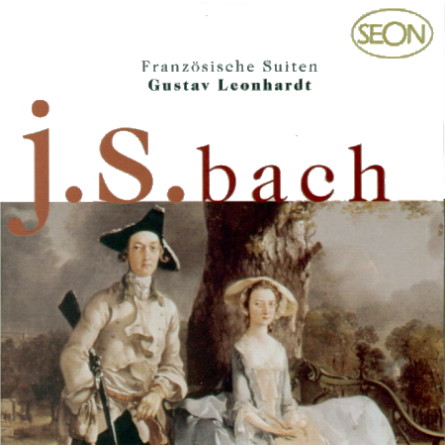 |
2 LPs
- 6775 021 - (p) 1976
|
 |
1 LP -
RL 30812 - (p) 1982
|
 |
| 1 CD -
SBK 60717 - (c) 1999 |
|
FRANZÖSISCHE
SUITEN
|
|
|
|
|
|
|
|
| Johann Sebastian
BACH (1685-1750) |
Suite
No. 1 in D Minor, BWV 812 |
|
12' 27" |
|
|
-
Allemande |
2' 07" |
|
A1
|
|
-
Courante |
2' 11" |
|
A2 |
|
-
Sarabande
|
3' 04" |
|
A3 |
|
-
Menuett I & II
|
2' 41" |
|
A4 |
|
-
Gigue |
2' 19" |
|
A5 |
|
Suite No. 2 in C Minor, BWV
813
|
|
11' 42" |
|
|
-
Allemande |
3' 20" |
|
A6 |
|
-
Courante |
2' 03" |
|
A7 |
|
-
Sarabande |
2' 16" |
|
A8 |
|
- Air |
1' 00" |
|
B1 |
|
-
Menuett |
1' 07" |
|
B2 |
|
-
Gigue |
1' 55" |
|
B3 |
|
Suite
No. 3 in H Minor, BWV 814
|
|
14' 34" |
|
|
-
Allemande |
1' 55" |
|
B4 |
|
-
Courante |
2' 17" |
|
B5 |
|
-
Sarabande |
3' 12" |
|
B6 |
|
-
Anglaise
|
0' 50" |
|
B7 |
|
-
Menuett |
4' 07" |
|
B8 |
|
-
Gigue |
2' 07" |
|
B9 |
|
Suite
No. 4 in E-flat Major, BWV 815 |
|
12' 34" |
|
|
-
Allemande |
3' 28" |
|
C1 |
|
-
Courante |
1' 52" |
|
C2 |
|
-
Sarabande |
2' 15" |
|
C3 |
|
-
Gavotte
|
1' 01" |
|
C4 |
|
- Air |
1' 26" |
|
C5 |
|
-
Gigue |
2' 30" |
|
C6 |
|
Suite
No. 5 in G Major, BWV 816 |
|
14' 33" |
|
|
-
Allemande |
1' 56" |
|
C7 |
|
-
Courante |
1' 59" |
|
C8 |
|
-
Sarabande |
3' 50" |
|
C9 |
|
-
Gavotte
|
1' 11" |
|
D1 |
|
-
Bourrée |
0' 55" |
|
D2 |
|
- Loure |
2'
45" |
|
D3 |
|
- Gigue |
1'
56" |
|
D4 |
|
Suite
No. 6 in E Major, BWV 817 |
|
11' 57" |
|
|
-
Allemande |
1' 25" |
|
D5 |
|
-
Courante |
1' 50" |
|
D6 |
|
-
Sarabande - Double
|
2' 22" |
|
D7 |
|
-
Gavotte
|
1' 00" |
|
D8 |
|
-
Polonaise |
1' 16" |
|
D9 |
|
-
Menuet |
1' 35" |
|
D10 |
|
-
Bourrée |
1' 02" |
|
D11 |
|
-
Gigue |
1' 14" |
|
D12 |
|
|
|
|
|
Gustav
Leonhardt, Harpsichords
- David Rubio, Oxford, 1975, after Pascal
Taskin (BWV 812, 814, 815 & 817)
- David Rubio, Oxford 1973, after Pascal
Taskin (BWV 813 & 816) |
|
|
|
|
|
Luogo
e data di registrazione |
|
Doopsgezinde Kerk,
Amsterdam (Holland)
- Febbraio 1975 (BWV 813 &
816)
- Dicembre 1975 (BWV 812, 814, 815
& 817)
|
|
|
Registrazione: live
/ studio |
|
studio |
|
|
Producer /
Recording Supervisor |
|
Wolf Erichson
|
|
|
Recording Engineer
|
|
Dieter Thomsen
|
|
|
Prima Edizione LP |
|
Seon (Philips) | 6775
021 | 2 LP - durata 38' 43" - 39'
03" | (p) 1976 | ANA
Seon (RCA Red Seal) | RL 30812 | 1
LP - durata 38' 43" | (p) 1982 |
ANA | (BWV 812, 813 & 814)
|
|
|
Edizione CD |
|
Sony | SBK 60717 | 1
CD - durata 78' 26" | (c) 1999 |
ADD
|
|
|
Original Cover
|
|
-
|
|
|
Note |
|
-
|
|
|
|
|
Like the
"Inventions" and
"Sinfonias", the
"Welltempered Clavier I" and
the "English Suites", the
"French Suites" were also
created in the Köthen
period. These were the
artistically inspired
musical.director years,
during which Bach composed
his most significant
orchestral and chamber music
works. With the suites 1 to
5, which are still
incomplete in some respects,
Bach already began in 1722
to write in his own hand the
first little notebook for
his second wife Anna
Magdalena. The second,
produced in 1725, again
contains the first two
suites. Of the other copies,
one of the most carefully
written was that penned by
the Bach pupil H. N. Gerber
(around 1725). In addition
to the subsequently composed
sixth suite it notates all
cycles in their currently
accepted movement structure.
From the writings and copies
it becomes apparent that
this collection of suites,
too, had to go through an
artistic maturing process of
about three years before
taking on its final shape.
The tile "French Suites" did
not emanate from Bach
himself, who used the more
neutral phrase "Suites pour
le clavecin" for his pieces.
The naming of the collection
most probably goes back to a
contemporary of the St.
Thomas's church music
director. It has become just
as firmly accepted as the
non-autographic description
as "English Suites", without
any intention of expressing
any specifically national
style elements. The smaller
"French" are of less
technical performance
difficulty and are more
colourful and freer in the
movement sequence than the
large "English", which are
always introduced by a
wideranging prelude. These
differences shoul by no
means be construed as any
evaluation as to merits, but
the "French" in particular
still enjoy a great deal of
popularity. The six number
of the suites - the first
three in minor, the rest in
major keys - accords with
the opus arrangement in the
six compositions usual in
the baroque era. With regard
to the sequence, however,
Bach appears to heve been
influenced by the number of
the individual sections, the
first three consisting of
six, the fourth and fifth of
seven, and the last of eight
pieces. However, in no cycle
has Bach meddled with the
fundamentals of the German
suite, - the sequence of
allemande, courante,
sarabande, gigue, but merely
varied the number of free
dance movements between
sarabande and gigue.
The opening D minor suite
has a serious tenor,
corresponding with Bach's
respect for baroque key
characteristics. It is the
most markedly affected by
tradition of all six cycles:
in the motif linking of the
allemande, courante and
gigue in the manner of a
variations suite of the
early 17th century, and in
the strictly fugued pattern
of the gigue, whose dotted
4/4 beat is akin to the
Gautier type. An unusual
element is the sequence of
two minuets, the second of
which - on account of its
double lenght - cannot be
regarded as a trio to the
first. Suite No. 2 in C
minor is singular for its
major cantabile elenet.
The melodically sensitive,
extrovert allemande, in a
rhythmically difficult
setting, has a fully
convincing artistic effect
in its taut compactness.
Several versions widely
differing from each other
prove that over a long
period Bach must have
critically filed and
polished the flowing
courante in the Italian
style. Likewise a showcase
piece of individual
character is the air, whose
theme in the original from
and reversion is present in
almost every bar, and in the
second part experiences a
strongly contrapuntal
concentration. The fast
gigue with its hopping-like
rhythm is in the canarie
manner.
As with all Bach
compositions in this key,
the B minor Suite No. 3
serves to display a specific
esoteric emotion, which is
occasionally achieved by
unusual technical details of
movements. For instance, in
the allemande by the
constant recurrence of the
introductory four-note motif
in the nature of an
invention, in the courante
by the frequent rhythm
change between 6/4 and 3/2
time which gives the piece
something of a weightless
atmosphere, and in the gigue
by the uninterruptedly
flowing sixteenths motion.
More down to earth, but
still full of gracefulness,
is the E-flat major Suite
No. 4. It is remarkable how,
despite its simple
construction, the allemande
melody emphatically soars up
from the deepest range by
almost two and a half
octaves to g" in the first
part, and even farther
upward to c''' in the
second, then sinking down
again to the sonorous middle
range. The mischievous
gavotte is countered by a
reflective air, which in
turn contrasts with the
lively gigue, marked by
thematic fourth voices in
the Italian style.
The G major Suite no. 5 is
in an elated dance-like
mood. Although
quasi-harmoniously
improvising, the allemande
is kept in firm control by
taut partleading, and leads
on to the very agile
courante in the flow of
sixteenths. The pieces which
follow all display a genuine
dance character: the solemn
sarabande, the graceful
gavotte - one of the most
charming dances Bach ever
composed - the fleeting
bourrée, and the
ceremonious, Old
French-inspired loure. The
fugued gigue, making its
appearance in the bright
soprano range, is the most
virtuoso of all the "French
Suites". The radiant E major
Suite with its eight typical
dances forms the conclusion.
Which part of it can one
praise more? The beautifully
sonorous allemande, from the
figured two-voice framework
of which a third melody in
the highest motes emerges,
the pathos-laden srabande,
the gentle three-voice
gavotte, or the miniature
minuet, which with a paucity
of notes is capable of
providing such an enchanting
effect? Or should preference
be accorded to the brilliant
finale, the swelling gigue
which is so impressively
effective in its contrast
with the most delicate of
all delicate minuets? In
this suite any evaluation of
detail is doomed to failure
- one can only admire it as
a consummate whole, as the
undisputed climax of this
collection.
Lothar
Hoffmann-Erbrecht
English
translation by Frederick
A. Bishop
|
  |
|
|